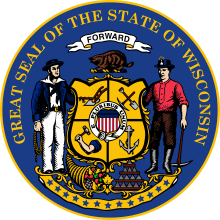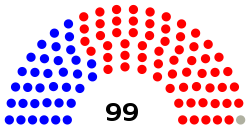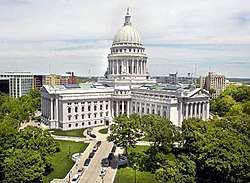Wisconsin Legislature
The Wisconsin Legislature is the state legislature of the U.S. state of Wisconsin. The Legislature is a bicameral body composed of the upper house Wisconsin State Senate and the lower Wisconsin State Assembly, both of which have had Republican majorities since January 2011. With both houses combined, the legislature has 132 members representing an equal number of constituent districts. The Legislature convenes at the state capitol in Madison.
Wisconsin State Legislature | |
|---|---|
 | |
| Type | |
| Type | |
| Houses | Senate Assembly |
| Leadership | |
Senate Majority Leader | |
Assembly Majority Leader | |
| Structure | |
| Seats | 132 33 Senators[1] 99 Representatives[2] |
 | |
Senate political groups | Republican (19) Democratic (14) |
 | |
Assembly political groups | Republican (63)
Democratic (35) Vacant (1) |
| Authority | Article IV, Wisconsin Constitution |
| Salary | $50,950 + $153 per diem |
| Elections | |
Senate last election | November 6, 2018 |
Assembly last election | November 6, 2018 |
Senate next election | November 3, 2020 |
Assembly next election | November 3, 2020 |
| Meeting place | |
 | |
| Wisconsin State Capitol, Madison | |
| Website | |
| http://www.legis.wisconsin.gov | |
History
The land that would become Wisconsin became part of the United States in 1783 and was first organized under the Northwest Ordinance. It became the Wisconsin Territory in 1836 and the state of Wisconsin on May 29, 1848.[3] The 1850s saw an influx of European immigrants.[4]
Women's rights groups in support of temperance and suffrage formed in Wisconsin in the 1860s.[5] The Wisconsin Women's Suffrage Association was formed in 1869. Suffrage bills were introduced in 1855 and 1867 but both failed. However, the state legislature did pass a law allowing women to run for school boards and elective school offices in 1869. It was not until June 10, 1919, that Wisconsin became the first state to ratify the 19th amendment granting national suffrage to women.[5]
Wisconsin was dominated alternately by the Republican and Progressive parties in the first century of its existence, but has been more competitive since then. The Republicans gained majority control in both houses in the 1995 Legislature, the first time since 1969. In 2009, the Democratic Party gained control of both houses for the first time since 1993.
The Republican Party took back control of both houses in 2011.[3] Governor Scott Walker then signed a new redistricting plan.[6] In 2012 elections, Democrats won a majority of the vote but Republicans retained control of the legislature, taking 60 of the 99 seats in the Assembly.[6] In Wisconsin elections, 2016, Republicans secured their largest majority in the Assembly since 1956.[6]
On November 21, 2016, U.S. Circuit Judge Kenneth Francis Ripple, joined by District Judge Barbara Brandriff Crabb, held that the Republicans' 2011 redistricting was unconstitutional partisan gerrymandering, over a dissent by District Judge William C. Griesbach.[7] The court found that the 2011 redistricting plan created three times as many wasted votes as the national average, violating the United States Constitution’s guarantee of one man, one vote.[8]
Membership
Qualifications and terms
To serve in the Wisconsin Legislature, individuals must be a resident of the state for at least one year preceding his or her election and be a qualified elector in the district they are elected to represent.[9]
All 99 members of the Wisconsin Assembly are elected in a two year term cycle without term limits. Similarly, all 33 members of the Wisconsin Senate are elected in a four year cycle, also without term limits.[9] Half of the Senate is elected every two years.[9] Prior to an amendment in the Wisconsin Constitution in 1881, Assembly members served a one year term, while Senators were elected every two years. The 100th Wisconsin Legislature began on January 3, 2011.
Officers
Members of both houses of the Legislature vote within their ranks to select presiding officers, such as the Speaker of the Assembly and the President of the Senate. These high level positions reflect the party majority in both chambers. An amendment to the state constitution in 1979 removed the Lieutenant Governor of Wisconsin as the presiding officer of the Senate, allowing Senators to vote within their ranks for a chamber president. Similarly, majority and minority leaders are also selected by party strength in the legislative houses and within their own respective caucus.
Salary and benefits
Legislators receive an annual salary of $49,943 and a per diem of up to $88 to cover living expenses when they are in Dane County, Wisconsin on state business, unless their district is in Dane County. Members of the Madison delegation may receive a per diem up to $44 to cover expenses. Legislators also receive $75 per month in "out-of-session" pay when the Legislature is in session for three days or less. Over two years, each legislator is allotted $66,008 to cover general office expenses, printing, postage and district mailings.
Rules and procedures
In both chambers of the Wisconsin Legislature, a quorum is defined as a majority of current members. The majority of a quorum is needed to pass legislation on the floor of the chamber.[10] Three-fifths of the members elected is the quorum necessary for passage or concurrence in either house of any fiscal bill. Proposals may not be introduced or offered unless they are put in proper form by the legislative reference staff if requested by members or members-elect of the legislature.[10]
References
- "2019 Wisconsin State Senators". docs.legis.wisconsin.gov.
- "2019 Wisconsin State Representatives". docs.legis.wisconsin.gov.
- Highlights of History in Wisconsin, Wisconsin Blue Book 2011-2012 (accessed April 25, 2013)
- 19th Century Immigration, Wisconsin Historical Society (accessed April 25, 2013)
- The Women's Suffrage Movement Wisconsin Historical Society (accessed April 25, 2013)
- Stein, Jason; Marley, Patrick (22 November 2016). "Federal court strikes down GOP-drawn maps". Milwaukee Journal Sentinel. Retrieved 24 November 2016.
- Michael Wines (22 November 2016). "Judges Find Wisconsin Redistricting Unfairly Favored Republicans". The New York Times. p. A1. Retrieved 24 November 2016.
- Soffen, Kim (23 November 2016). "Wisconsin's gerrymander being struck down should scare Republicans nationwide". The Washington Post. Retrieved 24 November 2016.
- Article IV, Wisconsin Constitution (accessed April 25, 2013)
- Procedures Derived from State Constitution Wisconsin Legislature (accessed April 25, 2013)